Srijan Class-9 Cell-A Unit of Life ICSE Biology Solutions Ch-1. We Provide Solutions of Concept Check-1, and 2,Very Short Ans, Short Ans, Long Ans, Multiple Choice Type(including True False), Application /Skill (Figure Based ) Questions by expert teachers as per ICSE board guidelines. Visit official Website CISCE for detail information about ICSE Board Class-9.
| Board | ICSE |
| Publications | Srijan Publication |
| Subject | Biology |
| Class | 9th |
| writer | Veer Bala Rastogi |
| Book Name | …………. |
| Topics | Solutions of Concept Check-1, and 2,Very Short Ans, Short Ans, Long Ans, MCQ, Application Skill Based Questions |
| Edition | 2021-2022 |
Srijan Class-9 Cell-A Unit of Life ICSE Biology Solutions Ch-1
–: Included Topics :–
Concept Check 1
Concept Check 2
A. VERY SHORT ANSWER TYPE,
B .SHORT ANSWER TYPE,
C .LONG ANSWER TYPE,
D. MULTIPLE CHOICE TYPE,
E. Application/Skill-based Questions
Note :- Before Viewing Srijan Solutions of Chapter-1 Cell – A Unit of Life. Read the whole chapter carefully with figure. Focus on Structure of Cell, Endoplasmic Reticulum, Cytoplasm Golgi Body ,Plastid Centrosome and Nucleus. Chapter-1 Cell – A Unit of Life is very important Chapter in ICSE Class 9th biology.
Cell-A Unit of Life ICSE 9th Solutions Srijan Publishers
Concept Check 1 (Page 10)
Question 1:
Fill in the blanks with suitable words.
1. The cell theory was formulated by ……………. and ……………….. .
2 Cell is a unit of function as all the …………….. reactions take place inside it.
3. All living cells arise only from ……….. cell.
Answer :
1. The cell theory was formulated by M.J. Schleider and Theodor Schwann.
2 Cell is a unit of function as all the metabolic reactions take place inside it.
3. All living cells arise only from pre-existing cell.
Question 2:
Name the following.
1. Human amoeboid cells
2 The cells that open and close the stomata
3. Cells that conduct the impulse
Answer :
1. Human amoeboid cells – White blood cells.
2 The cells that open and close the stomata – Guard cells.
3. Cells that conduct the impulse – Nerve cells
Cell-A Unit of Life ICSE 9th Solutions Srijan Publishers
Concept Check 2 (Page 17)
Question 1:
State whether the following statements are true or false, If false, write the correct statement by changing the incorrect word/words only.
1. Cytoplasm and nucleus together constitute protoplasm.
2. Mitochondria help in the synthesis of food by trapping solar energy
3. Animal cells have fewer but large vacuoles.
4. Centro0some is present in animal cell but absent in plant cell.
5. In plant cells, a definite cell wall made of lipids is present.
Answer :
1. Cytoplasm and nucleus together constitute protoplasm. True
2. Mitochondria help in the synthesis of food by trapping solar energy False
3. Animal cells have fewer but large vacuoles. False
4. Centro0some is present in animal cell but absent in plant cell. True
5. In plant cells, a definite cell wall made of lipids is present. False
Cell-A Unit of Life ICSE 9th Solutions Srijan Publishers
A. VERY SHORT ANSWER TYPE, (Page 18)
Question 1:
Give one word for the following :
(a) The outermost nonliving covering found in a plant cell
(b) Plastid containing green pigment
(c) The organelles called suicide bags of the cell
(d) The part which provides rigidity and support to the plant cell.
(e) The structure in the cell that contains a network of chromatin material.
Answer :
(a) Cell Wall
(b) Chloroplast
(c) Lysosomes
(d) Cell Wall
(e) Nucleus
Question 2:
Which parts of a cell are concerned with the following :
(a) Liberation of energy
(b) Trapping of solar energy
(C) Transmission of characters from parents to offspring
(d) Synthesis of proteins.
Answer :
(a) Mitochondria
(b) Chloroplast
(c) Genes
(d) Ribosomes
Question 3:
State whether the following statements are true or false :
(a) The term ‘cell’ was coined by Leeuwenhoek
(b) The cell is the structural and functional unit of life.
(c) The cells observed by Robert Hooke in a slice of cork were living cells.
(d) According to cell theory, new cells arise from pre- existing cells.
(e) All animal cells possess a cell wall.
(f) Genes are located in chromosomes.
Answer :
(a) False
(b) True
(c) False
(d) True
(e) False
(f) True
Question 4:
Fill in the Blanks with suitable words :
(a) Cell is the basic structural and ………….. unit of life.
(b) Cell was discovered by ………….
(c) …………….. are called suicidal bags of cell
(d) Nucleus is surrounded by a membrane called ………….
(e) The expanded form of RŅA is ……………… and that of DNA is …………
(f) ………………….. are hereditary units.
(g) ………………… contain a green pigment
(h) ………………… is a plastid which stores starch.
Answer :
(a) Function
(b) Robert Hooke
(c) Lysosomes
(d) nuclear envelope
(e) Ribo Nucleic Acid, Deoxyribo Nucleic Acid
(f) Genes
(g) Chlorophyll
(h) Leucoplast
Question 5:
Match the columns.
Column A
(a) Golgi apparatus
(b) Mitochondria
(c) Lysosomes
(d) Ribosomes
(e) Cell membrane
(f) Vacuole
Column B
(i) Semipermeable
(ii) Suicide bags
(iii) ATP
(iv) Secretion
(v) Tonoplast
(vi) Protein synthesis
Answer :
(a) Secretion
(b) ATP
(c) Suicide bags
(d) Protein synthesis
(e) Semipermeable
(f) Tonoplast
Cell-A Unit of Life ICSE 9th Solutions Srijan Publishers
B .SHORT ANSWER TYPE, (Page 18)
Question 1:
Give reasons for the following :
(a) Lysosomes are called suicide bags of the cell.
Ans-
Lysosomes are known as suicide bags of the cell because they contain lytic enzymes capable of digesting cells and unwanted materials. … This causes the hydrolytic enzymes to be released.
(b) Cell is known as structural and functional unit of life.
Ans-
A cell is called as the fundamental structural and functional unit of life because they form the building blocks (bricks) of the main organs of organisms. The cells are the basic parts of all organs. These cells in group forms tissues that have specialized function and these tissues together form the organ
(c) Cells differ in size and shape.
Ans
Cells have different shape and size because different cell types have different functions. For example : Red blood Cells are shaped like a doughnut to carry more hemoglobin, and to fit through small spaces, and neurons are long and skinny to span wide places to send signals around the body
(d) Mitochondria are called the powerhouse of the cell.
Ans-
Mitochondria are known as the powerhouse of the cell because it is responsible for the extracting energy from food through cellular respiration. The energy is released in the form of adenosine triphosphate (ATP). It is an energy currency of the cell
(e) Prokaryotes have simpler cell organization
Ans-
Prokaryots have simpler cell organisation Because prokaryotes are those organisms Which are having only a single cell . They do not have membrane bound structures. They lack a true nucleus.
Question 2:
Give differences between the following:
(a) Cell wall and Cell membrane
Ans
| CELL WALL | CELL MEMBRANE |
|---|---|
| the thick and rigid structure with a fixed shape. | a thin and delicate structure. It is flexible to change the shape as needed. |
| cell wall protects the cell from the external environment. | cell membrane protects and maintains the internal environment of the cell. |
(b) Nucleus and Nucleolus
Ans
| Nucleus | Nucleolus |
|---|---|
| 1. Nucleus is the main organelle. | 1. It is the sub-organelle. |
| 2. It is membrane bound. | 2. It had non-membrane bound. |
| 3. It contains the genetic material called DNA | 3. It contains RNA. |
| 4. It is present in the cytoplasm. | 4. It is present in the nucleoplasm. |
(c) Eukaryotic cell and Prokaryotic cell
Ans
Structure Eukaryotic cell Prokaryotic cell
| Number of chromosomes | More than one | One–but not true chromosome: Plasmids |
|---|---|---|
| Cell Type | Usually multicellular | Usually unicellular (some cyanobacteria may be multicellular) |
| True Membrane bound Nucleus | Present | Absent |
| Example | Animals and Plants | Bacteria and Archaea |
| Nucleus | Present | Absent |
| Lysosomes and peroxisomes | Present | Absent |
| Microtubules | Present | Absent or rare |
| Endoplasmic reticulum | Present | Absent |
(d) Chloroplast and Chromoplast
Ans
| Chloroplasts | Chromoplasts |
| 1. They are green plastids. | 1. They are non-green coloured plastids. |
| 2. They contain chlorophylls and carotenoids | 2. Chlorophylls are absent. Only carotenoids are present |
| 3. Lamellae are present. | 3. Lamellae are absent. |
| 4. Chloroplasts are sites of photosynthesis. | 4. They add colour to the organs (e.g., flowers, fruits) for attracting animals to perform pollination and fruit dispersal |
Cell-A Unit of Life ICSE 9th Solutions Srijan Publishers
C .LONG ANSWER TYPE, (Page 19)
Question 1 :
Give main features of cell theory? Who formulated it.
Answer
main features of cell theory
Question 2:
List any five common features found both in plant and animal cells.
Answer
Write about the structure and functions of nucleus.
Answer-
Structure Of Nucleus
- Typically, it is the most evident organelle in the cell.
- The nucleus is completely bound by membranes.
- It is engirdled by a structure referred to as the nuclear envelope.
- The membrane distinguishes the cytoplasm from the contents of the nucleus
- The cell’s chromosomes are also confined within it.
- DNA is present in the Chromosomes, and they provide the genetic information required for the creation of different cell components in addition to the reproduction of life.
Question 4:
Draw a labelled diagram to show the structure of a plant cell.
Answer-
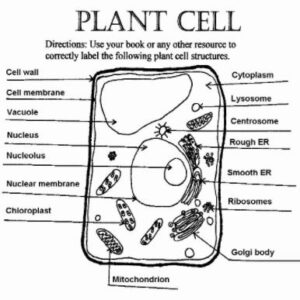
Question 5:
Mention three features found only in plant cells and one found only in animal cells.
Answer-
Animal cells each have a centrosome and lysosomes, whereas plant cells do not. Plant cells have a cell wall, chloroplasts and other specialized plastids, and a large central vacuole, whereas animal cells do not
Cell-A Unit of Life ICSE 9th Solutions Srijan Publishers
D. MULTIPLE CHOICE TYPE, (Page 19)
Choose the correct answer.
Question 1 :
Living part of the cell is called
(a) Cell wall
(b) Cell sap
(c) Protoplasm
(d) Cytoplasm
Answer :
(c) Protoplasm
Question 2 :
Cell sap is found in
(a) Nucleus
(b) Chloroplast
(C) Vacuole
(d) Golgi bodies
Answer :
(C) Vacuole
Question 3 :
Animal cell is different from plant cell in the presence of
(a) Centrosome
(b) Plastids
(c) Vacuole
(d) Golgi bodies
Answer :
(b) Plastids
Question 4 :
An important barrier between the protoplasm and outer environment in an animal cells is
(a) Cell wall
(b) Plasma membrane
(c) Nuclear membrane
(d) Tonoplast
Answer :
(b) Plasma membrane
Question 5:
5 Organelle connected with protein synthesis is
(a) Chloroplast
(b) Ribosome
(c) Pyrenoid
(d) Mitochondria
Answer :
Cell-A Unit of Life ICSE 9th Solutions Srijan Publishers
E. Application/Skill-based Questions (Page 19)
Question 1:
Label the parts indicated by guidelines and answer the questions given below:
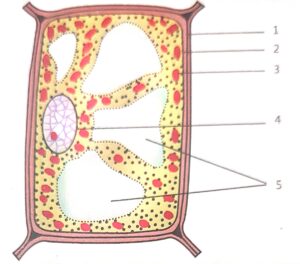
(a) Is the given diagram that of a plant cell or an animal cell ?
(b) Give three reasons that are visible in the diagram to support the answer given in (a).
(c) Mention any two function of the part labelled (4).
Answer :
(a) Plant cell
(b) Cell wall, Vacuole, Plastid
(c) Cell division, Transport genetic character to off spring
Question 2:
Observe the figure shown below and answer the following questions:
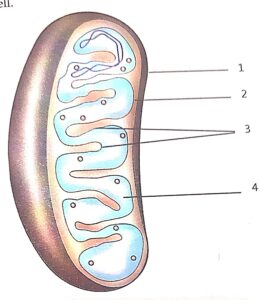
(a) Label the parts marked 1-4.
(b) What does this figure represent ?
(c) Mention the role performed by this structure in the cell.
Answer :
(a)
1. Outer membrane
2. Inner membrane
3. Outer chamber
4. Matrix
(b) Mitochondria
(c) Power house of the cell
— End of Srijan Class-9 Cell-A Unit of Life ICSE Biology Solutions Ch-1

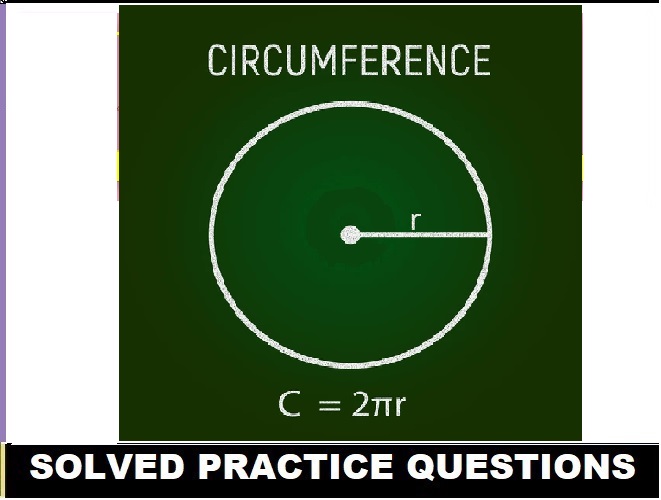
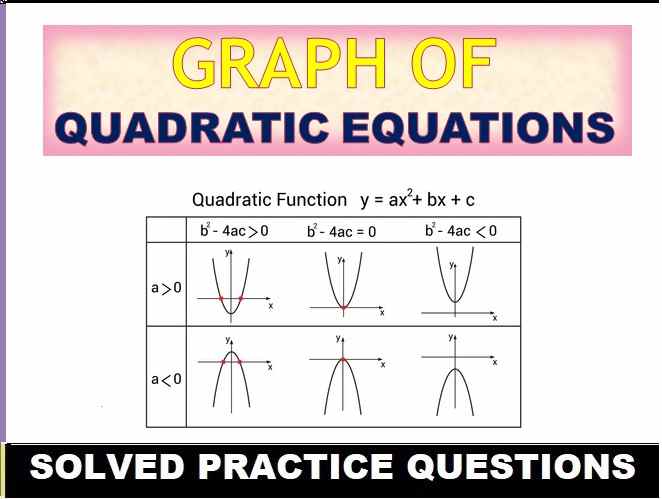
It was very helpful
thanks and keep touch
YES
It is really good and help me to solve my problem in studies very very thankful to those person who makes this website